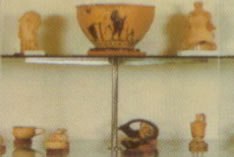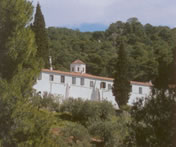 In
ancient times Poros was sacred to Poseidon and a major temple was located 12 km north of Poros town
at Vayonia. Built circa 500 BC, little remains today of what was probably
a magnificent structure except for a few walls and one Doric column. The
site (Palatia) however, offers a unique view of the open sea and to Troizinai
opposite on the mainland.
In
ancient times Poros was sacred to Poseidon and a major temple was located 12 km north of Poros town
at Vayonia. Built circa 500 BC, little remains today of what was probably
a magnificent structure except for a few walls and one Doric column. The
site (Palatia) however, offers a unique view of the open sea and to Troizinai
opposite on the mainland.
 Mythological
tradition makes Poros as the birthplace of Theseus and history names it
as the spot where the famous Athenian and orator Demosthenes died.
Demosthenes sought refuge and committed suicide within the Temple of Poseidon. He was actively opposed to Phillip of
Macedon and his son Alexander
the Great's domination of the Athenian city-state.
Mythological
tradition makes Poros as the birthplace of Theseus and history names it
as the spot where the famous Athenian and orator Demosthenes died.
Demosthenes sought refuge and committed suicide within the Temple of Poseidon. He was actively opposed to Phillip of
Macedon and his son Alexander
the Great's domination of the Athenian city-state.
 Demosthenes poisoned
himself rather than surrender to the Macedonians. You can see the ruins of the 6th Century Temple of Poseidon near the center of Kalavria.
Demosthenes poisoned
himself rather than surrender to the Macedonians. You can see the ruins of the 6th Century Temple of Poseidon near the center of Kalavria.
Throughout the 7th Century BC Poros was the center of the 7 island amphictyony (maritime confederation) of Kalavreia which preceded the Delian league centered at Delos island Cyclades just off Mykonos.
 Visit the Poros Archeological Museum (above left) Open 6 days, closed Mondays 8:30 - 15:00 tel: 22980-23276
Visit the Poros Archeological Museum (above left) Open 6 days, closed Mondays 8:30 - 15:00 tel: 22980-23276
Poros played an active part in the Greek War of Independence and was home to the first official Naval Dockyard in 1830.
 Today the
main historical attraction of the island is the Monastery
of Zoodoghos Pigis or 'Virgin of the life giving spirit' situated
7 km NE of Poros town. The l8th Century monastery is built around the island's only spring. Its deeply wooded grounds overlook Askeli bay.
It's noted for its finely carved wooden iconostasis. Within the grounds lies
its cemetery, where fighters of the War of
Independence against the Turks are interred. You can also see the grave of a British philhellene who
gave his life in the struggle. Don't miss the archeological
museum in Poros Town.
Today the
main historical attraction of the island is the Monastery
of Zoodoghos Pigis or 'Virgin of the life giving spirit' situated
7 km NE of Poros town. The l8th Century monastery is built around the island's only spring. Its deeply wooded grounds overlook Askeli bay.
It's noted for its finely carved wooden iconostasis. Within the grounds lies
its cemetery, where fighters of the War of
Independence against the Turks are interred. You can also see the grave of a British philhellene who
gave his life in the struggle. Don't miss the archeological
museum in Poros Town.
Many islanders trace their roots back to Albanian forebears.